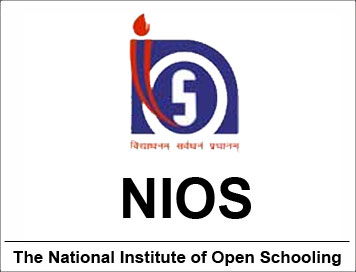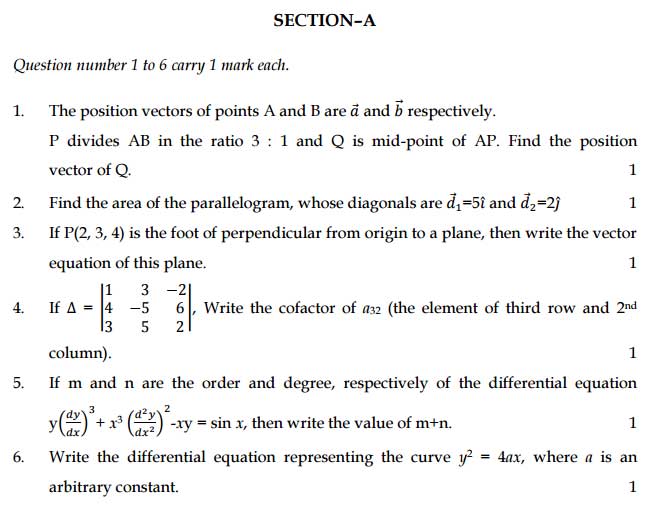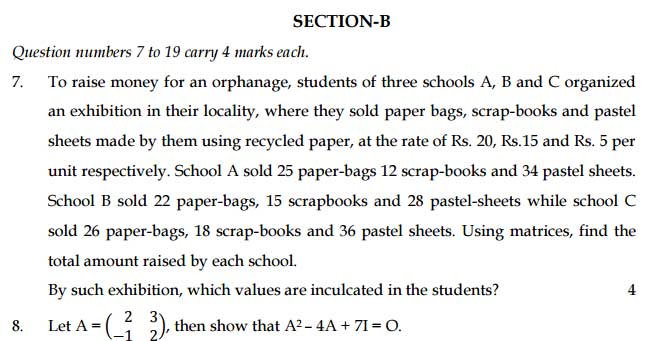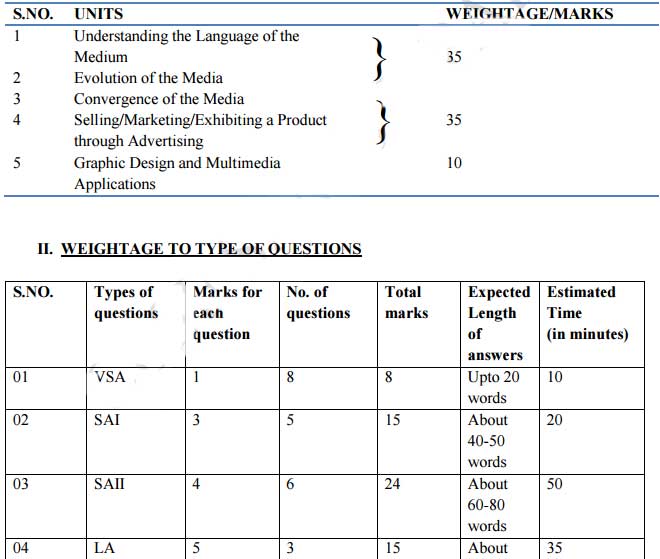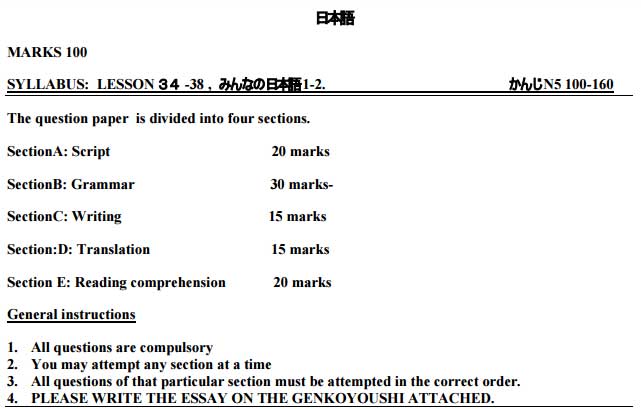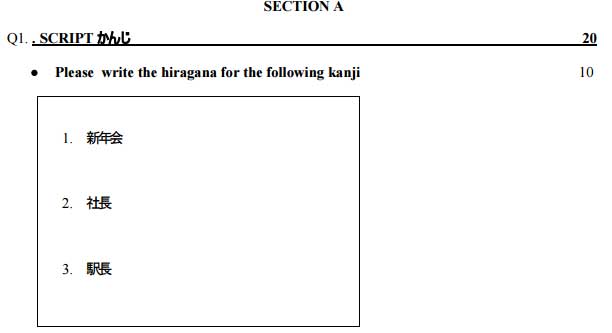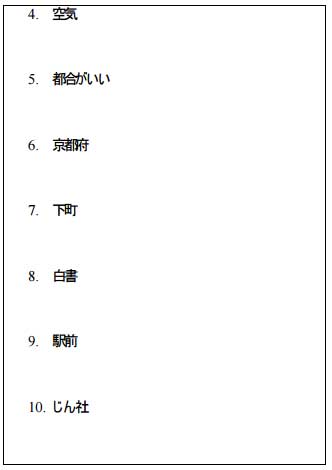
CBSE Class-12 Marking Scheme (Mass Media Studies) 2014-15
Question/Expected Answer
1. The Two Step Flow theory proposed by Paul Lazarsfeld, states that messages from the media get transmitted in two distinct stages:
1. Through Opinion Leaders who pay close attention to the mass media and its messages.
2. These opinion leaders then pass their own interpretations in addition to the actual media content
2. Folktales are stories that are distinguished by imaginative characters and their supernatural actions. They always seek to correct the wrongs and always have happy endings. They quite often state the fundamental wisdom.
3. Globalization, regionalization and democratization.
4. Lumiere-Realism, Documentary. Melies- Non-realism, Fantasy.
5. A genre is standardization of certain situations, character types, settings and other such conventions. Each genre has its specificities and its own history. Comedy, Western, Gangster, Detective, Film Noir, Musical, Sci-fi all these happen to be some of the prominent genres of American cinema.
6. Mise en scene [ pronounced 'meez-ahn-sen"] is a French term that literally means ' to put into scene' or ' staging an action'. This usually includes production design, set, location, actors and their movements, costumes, make up, sound, shot compositions and lighting. All these elements blend together in the construction/ composition of a scene in a film. In other words mise en scene signifies the director's control over the frames and individual shots.
7. Multimedia are the means to process and structure information into a well defined structure. Multimedia are called so because it incorporates many other media such as text, graphics, animation, audio and video.
8. Comparative advertising compares one brand directly or indirectly with one or more competing brands. This is very common and is used by nearly every major industry. This type of advertising is particularly resorted to by companies that are introducing a new product in a competitive market.
PART B
9. The analysis of newspaper content suggests two broad categories of newspaper format
- Broadsheet Press (quality or serious press)…. Explanation with examples
- Tabloid Press (Popular or sensational press)… Explanation with examples
10. Online versions of newspapers are not a profitable enterprise in India - Access to the Internet is fairly widespread in the cities, though mainly via Cyber Cafes, schools, colleges and offices, though the cost of access at home is still unaffordable for most Indians. Home access to the net is limited to a small minority of the upper middle class in Tier 1 and Tier 2 cities The situation in rural areas is far worse. Except for around five thousand e-choupals (Internet Kiosks), rural India is ill-served. The largest segment of around the 42 million users are in the 18-35 age group; they comprise half of all users. But only 66% of these are 'active users', that is those who use the net at least once a month. Most are 'ever' users', those who access the net once in a while.
11. Using Multimedia one can make academic presentations, business pres entations, devise games, operate information kiosks etc. Following are the possible areas of application of multimedia: Can be used as a great support in planning and executing any project; Can be used to explain or propose a concept; Using Multimedia while preparing a content for any topic makes the process more organized and precise.
12. Vividh Bharati was started on 2nd October 1957, as a service of 'light entertainment' to compete with Radio Ceylon, which had begun directing a commercial service to India on powerful short-wave transmitters. Earlier, AIR had banned film music on its prgrammes, for it was felt that film music was too cheap and vulgar to be broadcast on AIR and its regional services. Sponsored programmes were introduced in May 1970. Initially, 60% of the time was devoted to film music. The rest of the time was given to devotional music, short plays, short stories and poetry recitals.
13. Journalism as a craft, a profession and even as a cultural industry and a business, is over three centuries old. It was made possible by the coming together of a number of technologies as well as of several social, political and economic developments. The main technologies that facilitated the development of large-scale printing and distribution of print material were the printing press, the telegraph and the railways. The industrial revolution and the growth of capitalism, democracy and the public sphere provided the impetus and the support for rapid developments in the press.
14. Tabloid Journalism' is frequently termed 'yellow journalism' primarily because of its tendency to sensationalize and trivialise events, issues and people. The staple of the 'tabloids' is the private lives of famous people, crime, accidents, disasters, public corruption, sex, etc.(E.g. Midday, Mumbai Mirror, Pune Mirror). Tabloid journalists are believed to indulge in 'Chequebook Journalism' which implies that the subjects of the news stories are bribed to sell their 'true confessions'. Such journalists are also believed to indulge in 'keyhole journalism' or 'sting journalism' in their attempts to probe the private sexual infidelities and peccadilloes of well-known people and public officials. Then there is 'Page 3' Journalism which focuses on the social lives of celebrities and film stars and sports heroes.These journalistic practices raise several ethical questions about the invasion of the privacy of individuals and the public's right to information.
15. Analogue Signal- An analogue signal is any continuous signal. Varying quality of a signal represents changes in the process. Analogue is usually thought of in an electrical context; however, mechanical, pneumatic, hydraulic, and other systems may also convey analogue signals. Real-world values are measured or dealt within real-world parameters. Digital Signal- A digital system uses discrete (discontinuous) values. The information represented can be either discrete, such as numbers, letters or icons, or continuous, such as sounds, images, and other measurements of continuous systems. Digital is most commonly used in computing and electronics. Real-world information is converted to a digital format as in digital audio and digital photography.
16. Subjective. Content -2 marks. Expression-2 marks.
17. Jerome Bruner [B. 1915- USA] is an eminent psychologist, who has made landmark contribution to cognitive psychology, the study of human thinking and intelligence. In 1991, he published an article in the academic journal 'Critical Inquiry' entitled "The Narrative Construction of Reality." He outlines ten important characteristics of Narrative and they can be stated in a simplified manner as follows-
1. Time - Narratives take place over a period of time.
2. Particularity: Narratives deal with particular events.
3. Characters with qualities: The characters within Narratives have "beliefs, desires, theories, values, and so on".
4. Story: Narratives are composed as a selected series of events that constitute a "story."
5. Canonicity and breach: Stories are about some unusual happenings that "breaches" the canonical (i.e. normal) state.
6. Referentiality: The principle that a story in some way is always related to reality, although not in a direct and provable way.
7. Genericness: The story can be classified as a genre.
8. Normativeness: The observation that narrative in some way supposes a claim about how one ought to act. It may render moral suggestion perhaps. This follows from canonicity and breach.
9. Context sensitivity and negotiability: Narrative requires a negotiated role- meaning an active participationbetween author or text and reader. The readers/receivers have to understand the context of the narrative, and ideas like suspension of disbelief.
10. Narrative accrual: Finally, the idea that stories are cumulative, that is, that new stories usually are born from older ones.
18. Celebrity endorsements can be very popular and build strong associations in the buyers, but they are quite expensive to produce and air on prime time. Even state Governments are using celebrities as brand ambassadors. Merchandise- good, clothes bearing the logo or names or designs of the products are another popular way to advertise, but it will be limited to the class of buyers. It is also called Specialty Advertising. A company can have its name put on a variety of items, such as caps, glassware, gym bags, jackets, key chains, and pens. Since these items remain in use over a long period of time, most companies are successful in achieving their goals for increasing public recognition and sales through these efforts. Games (Mobile and computer) can be devised to promote the brand, but the reach is limited to mostly the young or tech savvy consumers. Covert advertising is presently a hot trend in promoting products and services. It embeds a product or brand in entertainment and media. Like Aston Martin has promoted itself as the high profile car used by the legendary character James Bond. The brand and car will have a very dramatic visual presence in the film.
19. "Quota sampling is a method for selecting survey participants. In quota sampling, a population is first segmented into mutually exclusive sub-groups. Then judgment is used to select the subjects or units from each segment based on a specified proportion. For example, an interviewer may be told to sample 200 females and 300 males between the age of 45 and 60. This means that individuals can put a demand on who they want to sample (targeting)" {Rest of the answer is subjective}
20. Brief introduction of the three audience theories. Analysis – Hypodermic theory and Twostep flow theory saw the audience as passive or made up of people who simply accepted whatever was put in front of them. They assumed that the content of the media has some effect on the audience members and the researchers spent their time trying to locate and measure those effects. However, rarely substantial effects were found, perhaps because the model for the audience was too simplistic. In these models latter following the gratification approach, the audience is active. Audience members are seen as consumers of a media product, and as with consumers of other goods and services, they shop around, consider alternatives, and make choices. The uses and gratifications approach seems to provide a richer way of looking at the audience. Instead of asking,"How does the media change our minds?" the uses and gratifications researchers ask "What is the role of media in our lives?"
21. Student should be able to discuss any five points from the following During the process of Adaptation:
i. A new narrative is formed.
ii. The new narrative in formed another medium.
iii. Script-writer and Director is the new authors of this narrative.
iv. Historical and cultural context of the original may change.
v. The new narrative is an interpretation of the original.
vi. Cinema is able to add new things as it can borrow liberally from other arts.
vii. Cinema is able to do so, as it is a recording medium.
22. The answer can be derived from the chapter 'The Available Media': The chapter clearly mentions the advantages and disadvantages of all prominent forms of media.
23. The answer should have a good introduction, body and conclusion. The student can write an answer on the lines of the following-
Cinema is a recording medium. It has the facility to record images and sounds of various kinds. These images and sounds become part of the whole. When a writer writes a scene, he does describe in all details as we have seen in case of great novelists like Gorky and Dostoevsky. But that entire experience is received in verbal form by the reader. A reader reads the words assimilates them and then visualizes. This visualization is personal and everybody's images are subjective. The opposite of it happens, while watching a film. The Harry Potter that each reader imagines, while reading the book is different for each of the readers. The Harry Potter that they will see on screen will be the same for all them. In cinema, a scene is realized on the screen by various means. A scene will have a settinglike an interior/exterior of the house, building, park, pasture, highway, airport, village, desert, river, sea etc. Thus architecture comes into play.
The scene will be shot at a certain time of the day/night, in a certain season, will have appropriate lighting, objects, colours, forms, textures; so, elements of painting and sculpture are in operation. The scene will have the presence of actors in their costumes, speech and interrelationships; hence the most vital element of theatre is present. Music and atmospheric sounds form an important part of the film language. Language is present in spoken form as well written form. Thus we are always dealing with a composite language, when we are dealing with cinema. Therefore, Cinema is able to become a composite and complex language because its own language is formed by a convergence of many languages such as the literary, visual, musical, architectural and theatrical languages.
24. Subjective.
25. The answer can be drawn from the following
CPU- CPU or brain of the computer synchronises and processes all activities within. The efficiency of a computer is dependent upon the speed of the CPU in processing of data. The CPU of a multimedia computer should be at least 486 with math coprocessor. The Pentium processor is more efficient and is usually referred in Multimedia. The speed of the processor is measured in megahertz. It defines the number of commands the computer can perform in a second. Faster the speed, greater will be the efficiency. RAM of 16 MBs is minimally needed too, but a RAM of 32/64 MBs will make the process faster and more efficient.
Monitor- A monitor is used to see the computer output. Generally, it displays 25 rows and 80 columns of text. The text or graphics in a monitor is created as a result of an arrangement of tiny dots, called pixels. Resolution is the amount of details the monitor can render. Resolution is defined in terms of horizontal and vertical pixel (picture elements) displayed on the screen. Greater the number of pixels, better will be visualization of the image. Video grabbing card- To convert the analog video signal (VCR or video camera) to a digital signal, the computer requires special equipment called video grabbing card. This card is fitted into a free slot on the motherboard inside the computer and gets connected to an outside source such as TV, VCR or a video camera with the help of a cable.
Sound card- A computer can be used to compose music and for recognition of speech and synthesis. For this the computer needs to convert the conventional sound signals to digital signals. This is done by adding special component to the system called the sound card. CD Rom Drive- CD Rom has become a massive storage capacity of data upto 680 megabytes.To access CD ROM a very special drive known as cd-rom drive is required. Transfer Rate- Transfer rate is the amount of data the drive can transfer at a sustained rate from the CD to the CPU. This is measured in KB per second. For example, 1x drive is capable of transferring 150KB of data from the CD to the CPU.
Scanner- Scanner is an external hardware equipment connected to the computer which converts photographs to digital format attached to the computer. The scanner sends a beam of light across a picture or document and records it.
Touchscreen- A touchscreen is used where the user is required to touch the surface of the screen or monitor. It is a monitor that allows the user to interact with the computer by touching the display screen.
OR
The students can share their learning from the unit 'Graphic Design Multimedia Applications' and probably write about Photoshop, Pagemaker, Sound Forge and Flash.

